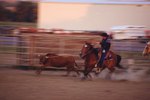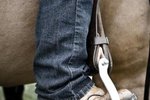The study of physics -- which that deals with the properties, changes, and interactions of matter and energy -- is not confined to the laboratory. You can apply this science to almost all everyday activities, including horseback riding. Regardless of your riding discipline, physics always plays a part. The various components of riding can be the subject of science projects.
Longing
Many riders longe -- guide the horse in a circle around them while it's tethered to a line 24 to 30 feet long -- to warm up the animal or remove excess energy before they mount. Often the horse will pull against the longe line as it travels, but as long as the rider manages to hang on to the horse, it will travel in the prescribed circle thanks to centripetal force. The exact amount of centripetal force can be measured through the formula Force = mass x (velocity squared / the radius). You can measure this force for several horses at different gaits for a project.
Balance
Once a rider mounts a horse, more concepts of physics take over. When a horse moves forward, the rider is thrown backward slightly according to Newton's First Law of Motion, which states that an item at rest will stay at rest unless acted upon by an outside force. In this case, the horse is an outside force to the human. The rider must continually adjust his balance or his equilibrium to stay with the horse and not be left behind the horse's center of gravity. This is especially true in such events such as barrel racing, reining and jumping. For this project, select several different equine activities. Determine where the horse's center of gravity is for each and the effect on the rider's balance as the horse changes speed or direction. For example, when a horse makes a sliding stop in reining, find the correct position for the rider in relation to the horse's center of balance. Explain what can happen when the rider is out of balance with the horse, using posters or videos to illustrate.
Show Events
Jumping a horse, whether part of a cross-country event or confined to a show ring, makes use of potential and kinetic energy. As the horse approaches a jump, it builds up speed or kinetic energy to send it over the fence. When the horse takes off, that kinetic energy is changed into potential energy. This built-up energy then determines how far and how high the horse will travel as it combats the force of gravity. Other events, such as mounted shooting depend on the rider's balance, the horse's speed and the angle of the rider's shooting. Studying the jumps of several different horses and reviewing the records of mounted shooting riders should reveal the optimum performance standards for each. Use posters to describe the types of energy used for each event.
Falling
An old saying goes,"There never was a horse that couldn't be rode, or a rider who couldn't be throwed." In looking at Newton's Third Law of Motion, which deals with momentum, it's easy to see what happens when a rider falls or is thrown. In the case of a horse who suddenly stops or changes direction, that forward motion is transferred to the rider who continues moving in a forward direction. Soon the rider runs out of horse and lands on the ground. The same is true for a horse that begins bucking and gets rid of his rider that way. Measure the force of impact in several different scenarios using the formula Force = Mass x Acceleration. Find the height of the rider's separation from the horse (it will vary from a simple fall to becoming dislodged over a jump or a buck) , then use gravity for the force and the rider's weight for the mass. Compare the resulting force of impact to the standards of different brands of protective gear to reveal how likely it is that a rider will be injured while using it. You may want to look a specific types of gear, such as vests and helmets, as well.
References
- Horse Riding Tips N Chat: Horse-Anatomy-Biomechanics
- Nancy Nicholson: Biomechanical Riding & Dressage
- Lew Hollander: Resonant Riding
- Horseman Pro: The Balanced Horse
- "Introduction to Physical Science": Patricia Horton, et al; 2005
Photo Credits
-
Jupiterimages/Photos.com/Getty Images
Writer Bio
Carolyn Kaberline has been a freelance writer since 2006. Her articles have appeared in local, regional and national publications and have covered a variety of topics. In addition to writing, she's also a full-time high-school English and journalism teacher. Kaberline earned a Bachelor of Arts in technical journalism from Kansas State University and a Master of Arts in education from Baker University.





